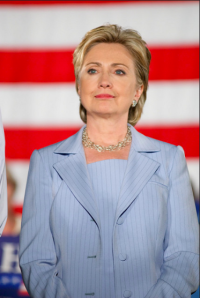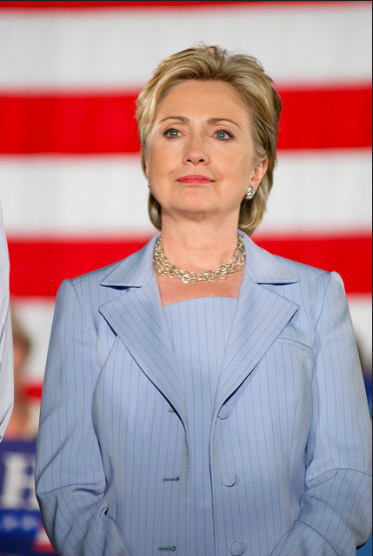By Margarita Artoglou

Recently, celebrity interviewers have been criticized by women for focusing too many of their questions towards female stars on their appearances. Beauty routines and methods of keeping one’s figure are common topics of conversation, along with the age-old, “Who are you wearing?” Male celebrities, on the other hand, are often asked more questions about the substance of their work.
This double standard also translates into the political arena. Lady lawmakers are often scrutinized for their outfits, while men’s clothing choices are largely ignored.
For example, after the 2016 presidential debates, little was said about Donald Trump’s clothing choices. There were, however, analyses of Hillary Clinton’s pantsuit of the day. Interestingly, Melania Trump’s outfits gained media attention, whereas no one cared much about Bill Clinton’s clothes. (More on Melania’s debate outfits later.)
While the tendency to focus on the dress choices of a woman in politics might stem from a place of sexism, these women are fully aware of the attention garnered by their outfits. Often these outfits are chosen with a purpose. Sometimes, a blouse is not just a blouse, but a medium through which to make a political statement.
Consider, for example, the purple pantsuit worn by Hillary Clinton when she gave her concession speech. The New York Times argued the color, the mix of red and blue, was meant to signify the union of a country divided by two political parties. It also would have been a fitting choice had Clinton won and delivered a victory speech instead.
Former First Lady Michelle Obama was often the subject of media criticism. Diane Detournay, professor of women’s studies, noted that Obama’s unique position as the first black First Lady led to her appearance being even more closely scrutinized in the media.
“Michelle Obama always had to perform a demonstration of class that didn’t apply to other First Ladies. Just the action of her showing her arms in a sleeveless dress caused a media crisis,” said Detournay.
Michelle Obama also seemingly understood the significance of her fashion choices. Throughout her time as First Lady, she often wore clothes by lesser-known designers and designers who were immigrants to the United States in order to help bring national attention to their brands. She wore a Narciso Rodriguez dress when she had her first meeting with Melania Trump at the White House, which is significant when one considers that Rodriguez is a Cuban immigrant and Donald Trump ran on an anti-immigration platform.
Melania’s clothing choices have also caused a bit of a media stir. At the second presidential debate, soon after the release of the infamous Access Hollywood tapes in which Donald Trump is heard saying he can “grab [women] by the pussy,” Melania donned a pink blouse that featured a pussy bow. While Trump campaign officials claimed it was a coincidence, many Internet users took to social media to contend that the blouse was a covert way for Melania to symbolically show that she was standing beside her husband despite the controversy.
Both Melania’s and Michelle’s dress choices made headlines on Inauguration Day as well. The incoming First Lady wore a light blue outfit by Ralph Lauren, while the outgoing wore a red dress by Jason Wu. The swapping of political party colors could signify an attempt at reconciliation (note that their husbands, however, stuck to their own party’s color when it came to ties).
The designer choices are also representative of what each First Lady’s administration stands for: Lauren is a well-established American designer, and the choice to be outfitted by him could be symbolic of the Trumps’ desire to return to the era of American manufacturing, while Wu is an Asian-Canadian designer whose brand was helped greatly by Obama in 2009 when the First Lady wore one of his creations to the Inauguration Ball.
Kellyanne Conway, formerly Trump’s campaign manager and currently a top White House aide, seems to enjoy drawing attention to herself through her nontraditional and sometimes outlandish choices. Case in point: her inauguration outfit, which consisted of a red, white and blue Gucci coat and a bright red hat, which she herself labelled “Trump revolutionary wear.” Twitter users quickly turned her into a meme and compared her to children’s book character Paddington Bear. Conway was rather combative in her response, saying she was “sorry to offend the black-stretch-pants women of America with a little color.”
It was not the first time Conway sported bright colors. She wore bright orange to the first Trump White House press briefing, and is often seen in red and bright pink hues. Conway’s color scheme draws attention to herself, which is apt for her, since she seems to genuinely enjoy media attention and being in the public eye. Compare her wardrobe to Melania Trump’s, which seems to be full of traditional shapes and colors, such as navy, black and white. Unlike Conway, the First Lady does not seem to enjoy being in the public eye, and so it would seem that she wears traditional clothes to blend in to her surroundings and not draw attention to herself.
The clothing choices of political women can be extremely meaningful. Some choices deliberately tell a story, while others do so unintentionally.
Perhaps one day, male politicians will be subject to the same kind of public fashion scrutiny—or perhaps women’s clothing choices will not matter as much, either. As of right now, though, the fashion picks of women like Obama, Conway and Trump are important in that they help each woman to project a carefully constructed image of herself.





































































































































































































